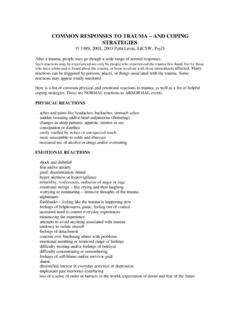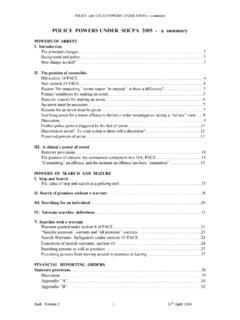Transcription of Parent-Child Interaction Therapy (PCIT) - Trauma …
1 Parent-Child Interaction Therapy (PCIT) 1 Trauma Treatment Fact Sheets vers. , 2004 National child Traumatic Stress Network Parent-Child Interaction Therapy (PCIT) Treatment Description PCIT is an evidenced-based treatment model with highly specified, step-by-step, live-coached sessions with both the parent/caregiver and the child . parents learn skills through PCIT didactic sessions, and, using a transmitter and receiver system, the parent/caregiver is coached in specific skills as he or she interacts in specific play with the child .
2 Generally, the therapist provides the coaching from behind a one-way mirror. The emphasis is on changing negative parent/caregiver- child patterns. The goals of treatment are an improvement in the quality of the Parent-Child relationship; a decrease in child behavior problems with an increase in prosocial behaviors; an increase in parenting skills, including positive discipline; and a decrease in parenting stress. Target Population PCIT was initially targeted for families with children ages 2-to-7 with oppositional, defiant, and other externalizing behavior problems.
3 It has been adapted successfully to serve physically abusive parents with children ages 4-to-12. PCIT may be conducted with parents , foster parents , or others in a parental/caretaker role. Caregiver and child must have regular, ongoing contact to allow for daily homework assignments to be completed. Intensity Treatment generally lasts 12-to-20 weeks and is mastery-based rather than time-limited. Generally, sessions are equally divided between relationship-enhancing skills and positive discipline and compliance skills. Homework sessions of 5-to-10 minutes each day are part of the treatment.
4 These sessions are designed to reinforce skills coached in session. To enhance long-term maintenance of PCIT benefits, parenting skills, and associated behavioral and Parent-Child relationship improvements, a schedule of booster sessions has been developed. Therapists generally recommend that the family participate in one-month, three-month, six-month, and one-year booster sessions. Essential Components The intervention uses a two-stage approach aimed at relationship enhancement and child behavior management. The parent is taught and coached in relationship-building skills: Praise, Reflection, Imitation, Description, and Enthusiasm (PRIDE.)
5 The parent/caregiver is coached while interacting with the Parent-Child Interaction Therapy (PCIT) 2 Trauma Treatment Fact Sheets vers. , 2004 National child Traumatic Stress Network Essential Components Cont d child during relationship-enhancement treatment sessions until criteria are reached. The parent is then instructed and coached in a positive discipline program including effective delivery of commands, with an appropriate parent response for child compliance and strategies designed to increase compliance. The skills are gradually expanded for use from a structured implementation in treatment sessions to structured sessions in the home to more unstructured situations and finally to use in public situations.
6 Skills are observed and coached through a one-way mirror at each treatment session. Specific behaviors are coded and charted on a graph at each session, and parents are provided with immediate feedback about progress and mastery of skills. parents are given homework assignments to complete to enhance their skills between sessions. Efforts are made to incorporate ethnic and cultural practices and values. Assessment Measures Used A core battery of assessment procedures include: Semi-structured intake interview child Behavior Checklist parent form Eyberg child Behavior Inventory Parenting Stress Index (short form) Dyadic Parent-Child Interaction Coding System-II Sutter-Eyberg Student Behavior Inventory (as appropriate) Outcome Measures Used PCIT concludes with a post-treatment evaluation.
7 In most cases, the pretreatment assessment procedures are repeated, including parent reports, teacher report, child report, and direct observation measures. The Dyadic Parent-Child Interaction Coding System-II observations are repeated at the end of the last discipline coaching session. parents also complete a parent-report measure of consumer satisfaction called the Therapy Attitude Inventory. parents and child return for post-treatment feedback sessions where pre- and post-treatment videotapes and accomplishments are reviewed. Brief parent report measures (Eyberg child Behavior Inventory, Parenting Stress Index) can be completed at booster sessions to assist in tracking maintenance of behavioral improvements or for long-term follow-up of treatment.
8 Training Requirements The training is for mental health professionals with a minimum of a master s degree in psychology or a related field. It involves 40 hours of direct training with ongoing supervision and consultation for approximately the next four-to-six months. The latter can be accomplished through conference calls, videotapes, and distance-learning technology. Competency criteria will be assessed at the completion of the 40-hour training with fidelity checks throughout the supervision and consultation period. Assessment instruments and scoring forms as well as the step-by-step clinician guide are needed for training (Hembree-Kigin, T, & McNeil, , Parent-Child Interaction Therapy .)
9 New York: Plenum, 1995) Manuals for detailed implementation of the treatment program, coding of sessions, and handouts for use in treatment will complement the guide. Parent-Child Interaction Therapy (PCIT) 3 Trauma Treatment Fact Sheets vers. , 2004 National child Traumatic Stress Network Fidelity Monitoring Procedures Session-by-session protocols and fidelity checklists filled out by the therapist and parent are essential. During the four to six months of supervision and consultation, the session-by-session protocols and fidelity checklists should be reviewed on a continual basis.
10 Implementation Requirements and Readiness Implementation involves two rooms, one for treatment, and one for observations and coaching. Generally this is accomplished through use of a one-way mirror system, bug in the ear device, video camera, and monitor, although in-room therapist coaching is also possible. The therapist is extremely active and directive during the sessions and must be able to commit to the family for up to 22 sessions. The therapist should have a referral network in place to address issues not covered by PCIT. Contraindications of Treatment PCIT is contraindicated as the first intervention when the following conditions exist: Severe, untreated adult psychopathology Severe marital discord Children outside of the PCIT age range Severe ADHD without medication consultation parents /caregivers who are known perpetrators of sexual abuse In many instances, PCIT may be successfully added to a comprehensive treatment plan if the above conditions are addressed first.








